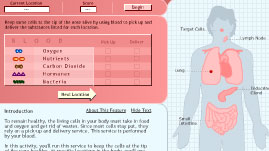What would it be like to be a cell? The answer depends on the type of cell you happened to be. If you were, say, an amoeba, a single-celled organism, you would use your pseudopod ("false foot") to crawl through your environment in search of food. Along the way you would absorb oxygen and get rid of carbon dioxide. But what if you were a cell that was part of a larger, more complex organism -- say, one of the ten trillion cells that make up the human body? Assuming that you were not a red or white blood cell, you'd be stuck in one place. You would still have the same needs as the amoeba -- to get food and get rid of wastes -- but you wouldn't be able to move around to take care of those needs. How, then, would you survive?
In order to stay alive and healthy, most of the cells that make up a multi-celled organism rely on blood and related fluids to make pick-ups and deliveries. Blood carries oxygen, mainly within red blood cells, from the lungs to all of the stationary cells in the body. Plasma, the liquid portion of the blood, carries some oxygen as well as nutrients from the small intestine and hormones from various endocrine glands. The blood absorbs waste products produced by the body's cells, such as carbon dioxide, and delivers them to various organs, which then expel the waste products from the body.
Most of the body's cells do not come in direct contact with the blood, which is inside blood vessels, so substances to be delivered and taken away must somehow travel from the blood to the cells. These substances travel through a clear fluid that surrounds all of the body's stationary cells. Actually, that fluid is the plasma portion of the blood. Plasma passes through the walls of tiny blood vessels, called capillaries, in the same way that sweat passes through your shirt on a hot day. When plasma moves through a blood vessel wall, it carries with it the nutrients and hormones it contains. Oxygen also moves from the blood through the capillary walls.
It might sound as though plasma "knows" that it is supposed to move through a capillary and even what substances need to be delivered to a cell and what ones need to be taken away. This is not so. There is a reason why plasma and the substances it contains move in the "right" direction. There is less oxygen in the plasma that surrounds the cells because that oxygen quickly moves into the cells as the cells burn food (nutrients) for energy. The same is true for the hormones that the cells use to help absorb the nutrients, and it's true for the nutrients as well. When the concentration of oxygen, hormones, and nutrients is greater in the blood than it is in the fluid, or greater in the fluid than it is in the cells, the substances move to where the concentration is lower. At the same time, as cells metabolize food, they create waste products such as carbon dioxide. When the concentration of carbon dioxide is greater in the cells than it is in the plasma, the carbon dioxide moves into the plasma. It then moves from the plasma into the blood vessels for the same reason. This process, by which a substance moves from an area of higher concentration to an area of lower concentration, is called diffusion.
So where does the plasma go after picking up wastes from the cells? It drains through the lymphatic system -- a network of vessels separate from the blood vessels of the circulatory system. Along the way, it passes through lymph nodes, which filter out unwanted substances such as bacteria. The lymphatic system connects to the circulatory system, where it returns the plasma to the blood.

 Loading Standards
Loading Standards Teachers' Domain is proud to be a Pathways portal to the National Science Digital Library.
Teachers' Domain is proud to be a Pathways portal to the National Science Digital Library.
